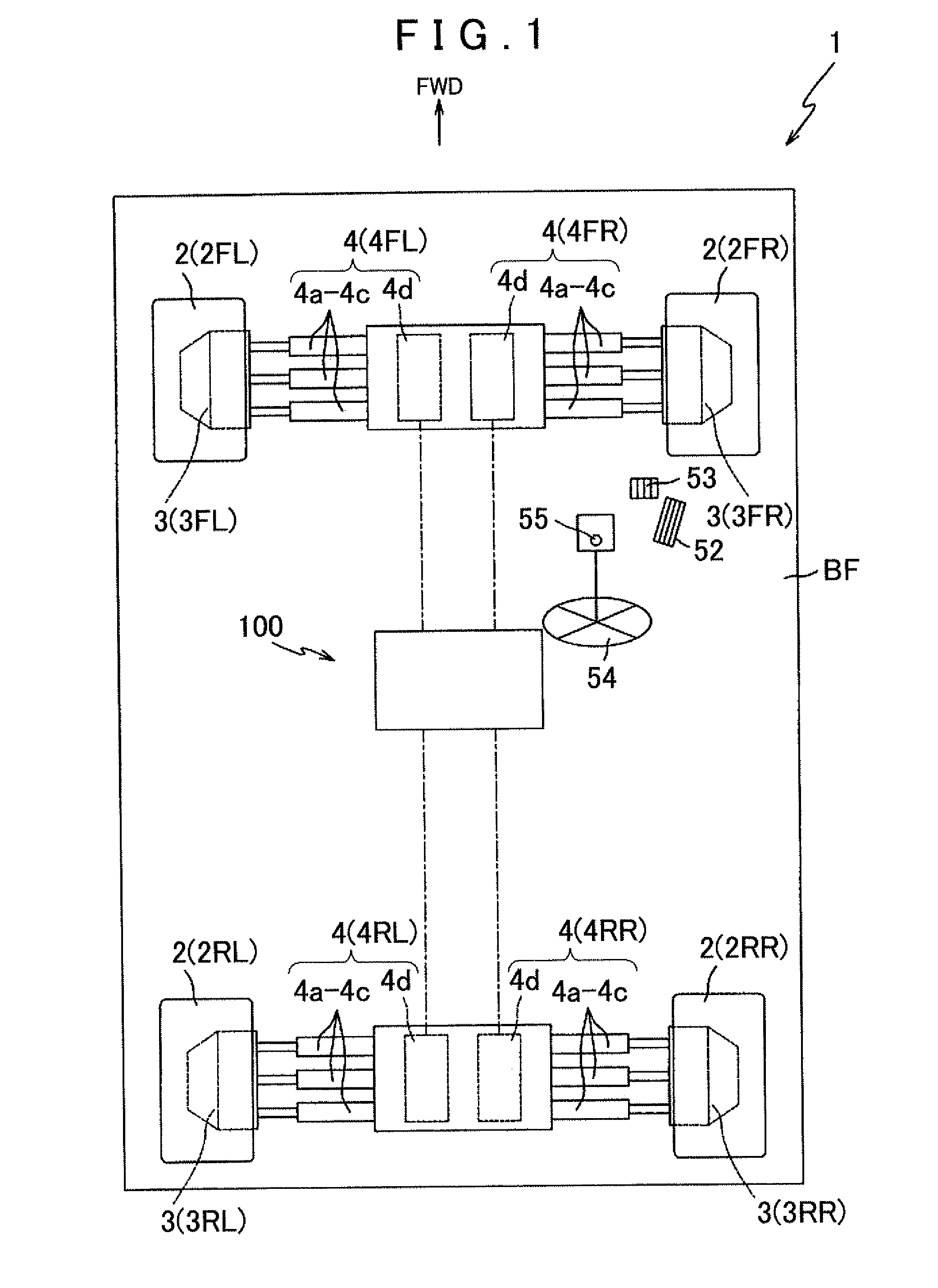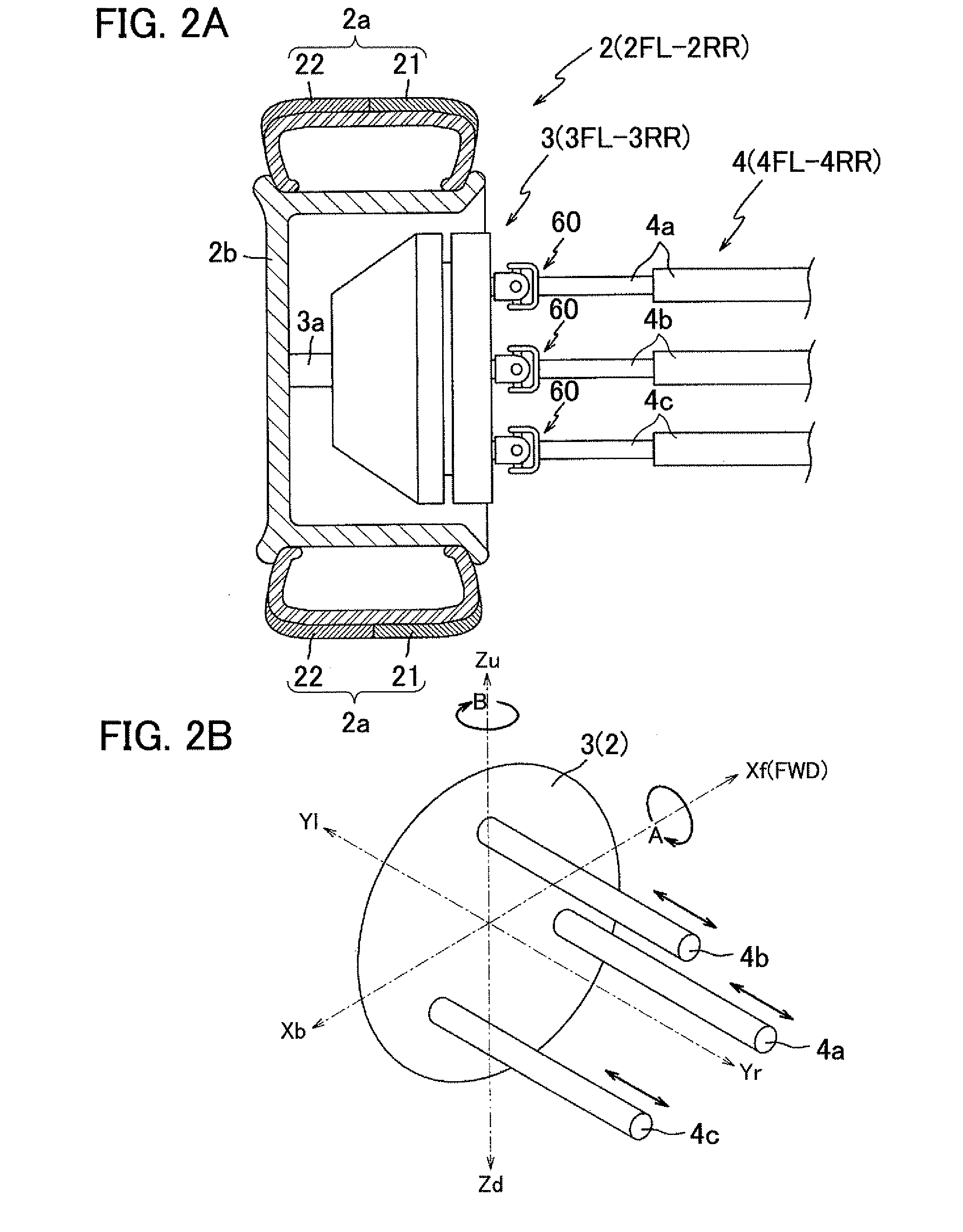Camber angle controlling device
a technology of controlling device and camera angle, which is applied in the direction of vehicle position/course/altitude control, process and machine control, instruments, etc., can solve the problem that the gripping force of the tire cannot be brought out sufficiently, and achieve the effect of high gripping force, low rolling resistance, and high gripping property
- Summary
- Abstract
- Description
- Claims
- Application Information
AI Technical Summary
Benefits of technology
Problems solved by technology
Method used
Image
Examples
first embodiment
[0126]Preferred embodiments of the present invention will be described below with reference to the accompanying drawings. FIG. 1 is a schematic diagram schematically showing a top view of a vehicle 1 equipped with a vehicular control device 100 according to the present invention. Note that an arrow FWD in FIG. 1 indicates the forward direction of the vehicle 1.
[0127]First of all, an outline structure of the vehicle 1 will be described. As shown in FIG. 1, the vehicle 1 is mainly provided with a vehicle body frame BF, a plurality of (four in the present embodiment) wheels 2 supported by the vehicle body frame BF, a wheel driving mechanism 3 that rotationally drives each of the wheels 2, and a camber angle applying device 4 that drives each of the wheels 2 for steering motion and camber angle adjustment thereof. The vehicle 1 is structured such that the vehicular control device 100 controls the operation of the camber angle applying device 4 to adjust the camber angles of the wheels 2...
second embodiment
[0266]As shown in FIG. 15, the wheel 202 is composed of only the first tread 21. Note that the wheel 202 is not necessarily composed of only the first tread 21 but may be composed of only the second tread 22.
[0267]Next, a camber angle map according to the second embodiment will be described with reference to FIG. 16. FIG. 16 is a schematic diagram schematically illustrating a content of the camber angle map according to the second embodiment. Note that the camber angle map shown in FIG. 16 is based on actual measurement values measured with respect to the wheel 202.
[0268]The CPU 71 determines a camber angle to be applied to the wheel 202 based on the content of this camber angle map. Note that, in FIG. 16, solid lines 201 and 202 correspond to the coefficient of friction and the rolling resistance, respectively. Although the camber angle map stores three types of maps corresponding to the three operating states of the road surface condition switch 55, FIG. 16 illustrates only one t...
third embodiment
[0287]As shown in FIG. 18, the vehicle 301 is provided with the engine 303 that rotationally drives some or all of the wheels 2 (left front wheel 2FL and right front wheel 2FR in the present embodiment).
[0288]The engine 303 is an engine for burning fuel such as gasoline or diesel oil and converting the thermal energy thus generated to power, and structured so as to be capable of applying the power to the wheels 2 (left front wheel 2FL and right front wheel 2FR) through drive shafts (not shown). A vehicular control device 300 feeds the fuel to the engine 303.
[0289]Next, a detailed structure of the vehicular control device 300 will be described with reference to FIG. 19. FIG. 19 is a block diagram showing an electrical configuration of the vehicular control device 300. As shown in FIG. 19, the vehicular control device 300 is provided with a fuel feeding device 336 and a fuel sensor device 335.
[0290]The fuel feeding device 336 is a device for feeding fuel (such as gasoline or diesel o...
PUM
 Login to View More
Login to View More Abstract
Description
Claims
Application Information
 Login to View More
Login to View More - R&D
- Intellectual Property
- Life Sciences
- Materials
- Tech Scout
- Unparalleled Data Quality
- Higher Quality Content
- 60% Fewer Hallucinations
Browse by: Latest US Patents, China's latest patents, Technical Efficacy Thesaurus, Application Domain, Technology Topic, Popular Technical Reports.
© 2025 PatSnap. All rights reserved.Legal|Privacy policy|Modern Slavery Act Transparency Statement|Sitemap|About US| Contact US: help@patsnap.com



